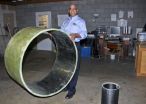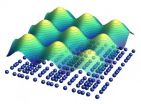(Press-News.org) TUCSON, Ariz. (August 17, 2012) -- Mo Ehsani, Professor Emeritus of Civil Engineering at the University of Arizona, has designed a new, lightweight underground pipe he says could transform the pipeline construction industry.
Instead of conventional concrete or steel, Ehsani's new pipe consists of a central layer of lightweight plastic honeycomb, similar to that used in the aerospace industry, sandwiched between layers of resin-saturated carbon fiber fabric.
In combination, these materials are as strong, or stronger, than conventional steel and concrete pipes, which are time-consuming and expensive to manufacture and transport.
Concrete and steel pipes are built in short sections to fit on standard 18-wheel trucks, but Ehsani's new pipe can be built onsite as a single section of virtually infinite length, hence the product name InfinitPipe.
The heavy industrial manufacturing processes, long-distance trucking, and leak-prone joints used in steel and concrete pipe construction exact a heavy toll on the environment, not to mention bottom line, which is why Ehsani's company, QuakeWrap, is marketing InfinitPipe as the world's first "green" pipe.
"There are really two aspects to this invention," Ehsani said. "One is this new type of lightweight honeycomb pipe. Second is our ability to give clients an endless or infinite pipe, without a joint. That is a big, big breakthrough in the pipeline industry that has implications for natural gas, oil, water, and sewer pipes."
A literally infinite pipe is, of course, not feasible, but Ehsani's method of manufacturing could create extremely long sections of joint-free pipe. "We could make a section a mile long," he said. "Of course, every thousand feet or so, you'd need an expansion joint so the pipe can breathe, but this would certainly not be the same concern we have today, where we have to put a joint every 20 feet."
The secret of producing virtually endless pipe sections lies in the manufacturing methodology. Ehsani wraps the various layers of carbon fabric and honeycomb around a mandrel, a kind of tubular mold with a cross-sectional shape that matches the pipe's internal cross-section, which is typically, but not always, circular.
"We basically start with a tube and wrap the materials on the outside," Ehsani said. "A couple of layers of carbon fabric, then we put on the honeycomb and then a couple of layers of carbon or glass fiber on the outside. This becomes the pipe."
After testing this manufacturing method, Ehsani had a "eureka" moment when he realized that the finished pipe could be partially slid off the mandrel, and more pipe could be added to the section of pipe remaining on the mandrel. "I thought, why don't we just slip this off of the mandrel and continue making this pipe?" Ehsani said. "Never stop."
Carbon fiber, resin and aerospace honeycomb are all very light materials that can be transported at a fraction of the cost of conventional prefabricated steel and concrete pipe, and Ehsani said he is looking for partners to develop an automated mobile unit to make the pipes onsite.
"Imagine having a truck with a mandrel in the back," Ehsani said. "You start making the pipe on, say, a 20-foot mandrel, and pull off 18 feet so you have two feet left on the mandrel," he said. "Then you just move the truck forward and drop the pipe in the ground, and keep adding pipe."
As if virtually eliminating transportation costs, slashing manufacturing costs, and reducing environmental impact weren't enough, Ehsani sees this pipe technology creating jobs and boosting local economies.
"Suppose you have a pipeline project in a developing nation," Ehsani said. "You could ship the raw materials to the workers there and they could make this pipe in their own village. No matter what size or shape they want, all they need to do is build a mandrel and make the pipe on the spot. We would be making it with local people under our supervision."
Closer to home, Ehsani cites the recently awarded $10.7 million contract to build the first four miles of pipe for the billion dollar Navajo-Gallup water supply project, which involves building a 280-mile pipeline to supply water to more than 40 Navajo communities in New Mexico and Arizona.
"The contractor is making a 42-inch diameter pipe for four miles, which works out to $507 a foot," Ehsani said. "Really, we could have that pipe built faster with the help of local labor and put it in place sooner, without having to wait to order it and ship it, and all of that expense."
Ehsani said he didn't really set out to turn pipeline construction on its head, but the project took on a life of its own. "We developed this originally with the intention of fixing existing pipes," he said. "Then as we started getting into this thing I realized it could be a real game-changing breakthrough technology."
The breakthrough did not happen overnight. In the late 1980s, Ehsani and Hamid Saadatmanesh, both of the UA department of civil engineering and engineering mechanics, pioneered research into repairing and retrofitting bridges and buildings using fiber-reinforced polymers, so the technology is well established.
"There's a lot of history on these materials," Ehsani said, which has enabled him to refine the pipe manufacturing process to use smaller amounts of better quality materials. "Because we're using our materials in a smart manner, we can afford to use the higher end material," Ehsani said. "So instead of cheaper glass fabric, we use carbon. Instead of polyester resin, we use epoxy. Because we don't have a solid core, we can afford to put the expensive material on the skin."
If Ehsani's concept for mobile pipe manufacture using lightweight components takes off, he envisions an industry freed from the shackles of heavy industrial plant. "As a business model, a company that wants to get into pipeline manufacturing with one of these mobile trucks could have a factory anywhere in the world," he said. "You could be doing a job in Hawaii today and next week be working in Panama. You're no longer limited by where your factory is."
INFORMATION:
More information on QuakeWrap can be found here: http://www.quakewrap.com/.
More information on the UA department of civil engineering can be found here: http://civil.arizona.edu/.
NOTE TO EDITORS: Ehsani will present a paper on his new pipe technology at the American Society of Civil Engineers Pipelines 2012 Conference, Aug. 19-22 in Miami.
UA engineering professor uses aerospace materials to build endless pipeline
2012-08-17
ELSE PRESS RELEASES FROM THIS DATE:
It must be important but what does it do? The strange case of UCP2
2012-08-17
When uncoupling proteins are active, mitochondria produce heat instead of ATP. This may be useful under certain circumstances, such as when an animal is hibernating. But non-hibernating animals also have them. Particularly poorly understood is the uncoupling protein UCP2. Elena Pohl and colleagues at the University of Veterinary Medicine, Vienna, show that the protein occurs mainly in cells of the immune system. The group's highly provocative findings are published in the online journal PLOS ONE.
Mitochondria represent the powerhouses of the eukaryotic cell. They ...
Iconic Darwin finch genome sequenced in Genome 10K international collaboration
2012-08-17
Santa Cruz, California—Scientists have sequenced the genome of one of the iconic Galapagos finches first described by Charles Darwin. The genome of the medium ground finch (Geospiza fortis) is among the first of a planned 100 genomes of vertebrate species to be sequenced and released by an international collaboration between the Genome 10K project and BGI.
This finch genome, the first of the BGI-Genome 10K collaboration to be made available through the UCSC Genome Browser, represents both a scientific and a symbolic advancement, according to Duke University associate professor ...
Magnetic turbulence trumps collisions to heat solar wind
2012-08-17
New research, led by University of Warwick physicist Dr Kareem Osman, has provided significant insight into how the solar wind heats up when it should not. The solar wind rushes outwards from the raging inferno that is our Sun, but from then on the wind should only get cooler as it expands beyond our solar system since there are no particle collisions to dissipate energy. However, the solar wind is surprisingly hotter than it should be, which has puzzled scientists for decades. Two new research papers led by Dr Osman may have solved that puzzle.
Turbulence pervades ...
Wild pollinators support farm productivity and stabilize yield
2012-08-17
Most people are not aware of the fact that 84% of the European crops are partially or entirely dependent on insect pollination. While managed honeybees pollinate certain crops, wild bees, flies and wasps cover a very broad spectrum of plants, and thus are considered the most important pollinators in Europe.
The serious decline in the number of managed honeybees and wild bees reported in Europe over the last few decades has the potential to cause yield decreases with threats to the environment and economy of Europe. The future of the pollination services provided by bees ...
War is not necessarily the cause of post-traumatic stress disorder
2012-08-17
A large-scale survey of the mental condition of military personnel before, during and after their posting to Afghanistan has proved thought-provoking. In total, 746 Danish soldiers took part in the survey. The soldiers completed a questionnaire five times in all – before their posting, during their time in Afghanistan and three times after their return to Denmark.
Professor Dorthe Berntsen of the Center on Autobiographical Memory Research – CON AMORE, Department of Psychology, Aarhus University, Business and Social Sciences, is responsible for the study, together with ...
Photographic cholesterol test
2012-08-17
Researchers in India have developed a total cholesterol test that uses a digital camera to take a snapshot of the back of the patient's hand rather than a blood sample. The image obtained is cropped and compared with images in a database for known cholesterol levels.
Writing in the International Journal of Medical Engineering and Informatics, N.R. Shanker of the Sree Sastha Institute of Engineering and Technology and colleagues describe how they have developed a non-invasive way to test cholesterol levels in patients at increased risk of heart disease. Their approach ...
Regions vary in paying prisoners to participate in research
2012-08-17
TORONTO, Aug. 17, 2012--When members of the public participate in research studies, they are often given incentives – such as cash or gift cards for food – as compensation or reimbursement for their time and effort. Not so for Canada's prison population. A new analysis shows that there is inconsistency in how and when incentives are used for research participants under criminal justice supervision.
Of the provinces, territories and federal government, only two jurisdictions have written policy around the use of research incentives, according to a national study led by ...
Constructive conflict in the superconductor
2012-08-17
Whether a material conducts electricity without losses is not least a question of the right temperature. In future it may be possible to make a more reliable prediction for high-temperature superconductors. These materials lose their resistance if they are cooled with liquid nitrogen, which is relatively easy to handle. An international team, in which physicists of the Max Planck Institute for Solid State Research in Stuttgart played a crucial role, has now discovered that this form of superconductivity competes with charge density waves, i.e. with a periodically fluctuating ...
A urine based 'potion' can act as a CO2 absorbent
2012-08-17
VIDEO:
A Spanish researcher has proposed human, agricultural and livestock waste, such as urine, as a way to absorb CO2.
Click here for more information.
The ocean, the ground, rocks and trees act as carbon drains but are far from places where greenhouses gases are concentrated, especially CO2. A Spanish researcher has proposed human, agricultural and livestock waste, such as urine, as a way to absorb this gas.
Absorbing the large quantities of carbon dioxide and other greenhouse ...
2 new owls discovered in the Philippines
2012-08-17
EAST LANSING, Mich. --- Two new species of owls have been discovered in the Philippines, and a Michigan State University researcher played a key role in confirming their existence.
The discovery, which is featured in the current issue of Forktail, the Journal of Asian Ornithology, took years to confirm, but it was well worth the effort, said the paper's lead author Pam Rasmussen, MSU assistant professor of zoology and assistant curator of mammalogy and ornithology at the MSU Museum.
"More than 15 years ago, we realized that new subspecies of Ninox hawk-owls existed ...



